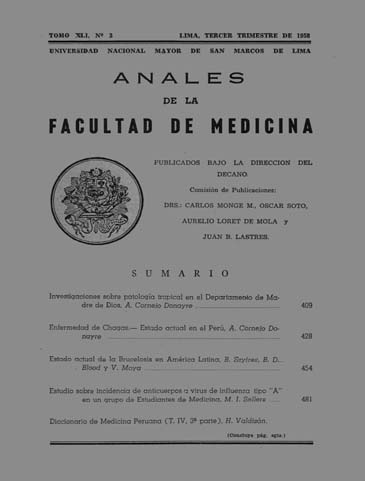Chagas Disease - Current Status in Peru
DOI:
https://doi.org/10.15381/anales.v41i3.8960Abstract
1.- Chagas disease is widely diseminated in the Peruvian territory, having been demostrated its existence in the departments of Tacna, Moquegua, Arequipa, Madre de Dios, Amazonas and San Martin. 2.- Up to 1957, 204 cases of Trypanosomiasis cruzi has been diagnosticated, of wich 202 belong to the last past 7 years, owing to the majoy number of epidemiological surveys wich took place in this lapse of time. 3.- A summary of the symptoms and signals observed in patients with Trypanosomiasis cruzi, diagnosticated in Perú, is submitted. It´s noted in it that the majority of acute cases were observed in children under five years of age and chronic cases in adults as well as in youngsters. 4.- Triatominos capable of trasmiting Chagas disease, were captured in the departments of Tacna, Moquegua, Arequipa, Ica, Lima, Junin, Cusco, Madre de Dios, La Libertad, Piura, Tumbes, Cajamarca, Amazonas and San Martin. 5.- The followong species of triatominos have been found in Perú: Triatoma infestans, Trianoma dimidiata, Triatoma carrioni, Panstrongylus herreri, P. geniculatus, P. Chinai, Panstrongylus rufotuberculatus, Belminus peruvianus, Rhodnius pallescens and Microtriatoma trinidadensis. T. infestans is the only vector in the southwest region and the P. herreri is the most important in the north of the country. T. infestans entered Peru from Chile and species T. dimidiata, T. carriori and P. rufotuberculatus possibly came from our neighbour republica of Ecuador. 6.- The most important reservoir of Trypanosomiasis cruzi in Peru is the guinea pig, but also cats and dogs have been found to be naturally infected in the endemic zone. 7.- The conditions and characteristics of the human dwellings in the urban zone, the rural and semi-rural of the endemic zone of Peru, constitutes the most important factor in the epidemiology of Chagas disease, since it has been demostrate thet the triatominos enter and reproduce itself easily in the interior of the rooms. Man live in a marked promiscuity with domestic animals which serve as reservoirs of T. cruzi, and the dwelling is overpopulated. 8.- Man acts as disseminator of Chagas disease transporting triatominos, guinea pigs, dogs and cats naturally infected by T. cruzi.Downloads
Published
1958-09-15
Issue
Section
Trabajos originales
License
Copyright (c) 1958 Alberto Cornejo Donayre

This work is licensed under a Creative Commons Attribution-NonCommercial-ShareAlike 4.0 International License.
Those authors who have publications with this magazine accept the following terms:
- Authors will retain their copyrights and guarantee the journal the right of first publication of their work, which will be simultaneously subject to Creative Commons Attribution License that allows third parties to share the work as long as its author and its first publication this magazine are indicated.
- Authors may adopt other non-exclusive licensing agreements for the distribution of the version of the published work (eg, deposit it in an institutional electronic file or publish it in a monographic volume) provided that the initial publication in this magazine is indicated.
- Authors are allowed and recommended to disseminate their work over the Internet (eg: in institutional telematic archives or on their website) before and during the submission process, which It can produce interesting exchanges and increase quotes from the published work. (See El efecto del acceso abierto ).
How to Cite
1.
Cornejo Donayre A. Chagas Disease - Current Status in Peru. An Fac med [Internet]. 1958 Sep. 15 [cited 2024 Aug. 16];41(3):428-53. Available from: https://revistasinvestigacion.unmsm.edu.pe/index.php/anales/article/view/8960















